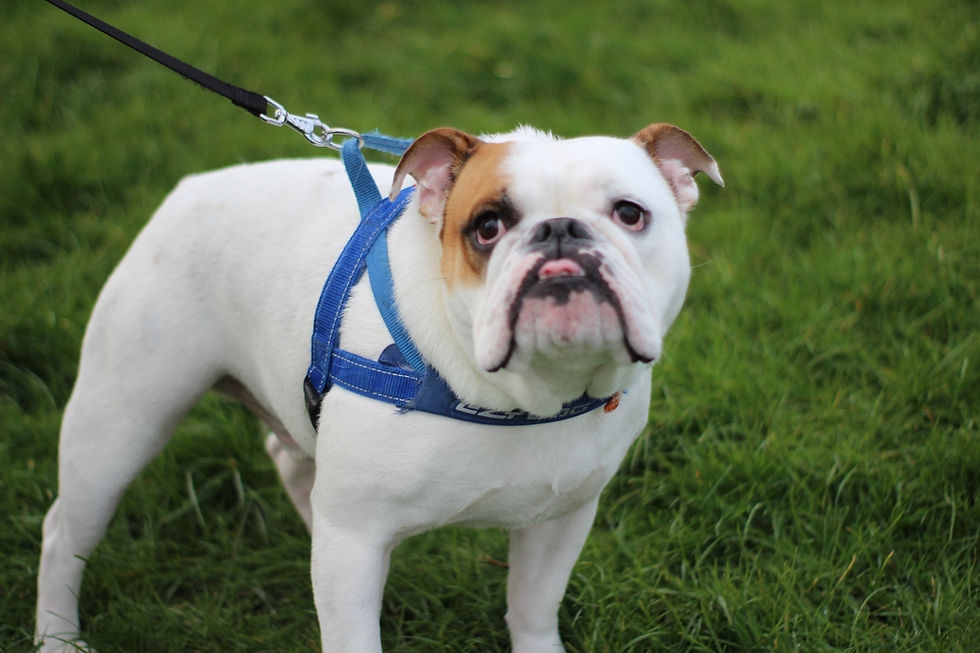Lead with your Voice
- Sarah Stonehouse
- Jan 18, 2023
- 3 min read
Do you ever drive down a country lane or a narrow road, come across a dog walker and watch as they pull their dog out of the way for you to pass? Are you that dog walker?
When you change direction on a walk, do you pull your dog away instantly?
Do you pull your dog away from other dogs or people they are showing an interest in?
Did you even realise you were doing it until you just read this?
Uh oh, maybe? Read on!

If you think about it, dogs lack so little choice in their lives that I'm surprised they want to do anything for us at all. We control when they eat, what they eat, how much they eat, where they walk, who they walk with, when they walk, who they meet, when they play, where they poo, etc. I could go on. Granted, they don't have to pay the bills and get waited on hand and foot but they're a dog... they don't understand that.
What dogs really need is a bit more choice. Quite often we don't realise we're using force until someone points it out. For example, the very first scenario I mentioned in this blog I see all the time. People dragging their dogs to the side of the road so my car can pass, before they've even let their dog know what they are doing. This is a great pet peeve of mine, but I smile and thank them as I pass because I know they aren't being malicious.
I see it mostly with smaller breeds, dogs naturally easier to pick up or move around manually. I imagine it's no coincidence that smaller breeds are more averse to touch and handling than larger dogs. I've met my fair share of touch-aggressive spaniels and chihuahuas. It's not quite as easy to pick up a bull mastiff and move them out of the way.
I see many dogs who aren't able to be moved around their house non-physically. They are picked up and moved, or solely bribed with a treat. The former have developed defensive behaviour, the latter have learnt to only move if food is present. Neither is desirable.
What lead-coercion or physical force does is:
Stunts problem-solving
Stunts independence
Stunts natural coping mechanisms
Stunts communication
Increases frustration
Increases reliance on physical touch to move our dogs
Increases handling aggression
Triggers panic in dogs prone to anxiety and stress
These things apply even if you don't mean to be forceful. You don't have to be intentional for mistakes to occur, so this is not a personal attack on anyone but it is designed to be educational. It may make you think next time you're walking your dog down a lane and a car approaches.
Things you can do instead (initially rewarded - not bribed - with treats but you can reduce these over time):
Practice recall
Use hand signals
Use a hand-touch
Use verbal cues
Lead shakes/wobbles/mild tugs (done gently as a nudge to get attention)
Practice a fun This Way/Let's Go!
Heel-walking with direction changes
Side notes:
If your dog is reacting or being aggressive or lunging at a person or dog or car, then obviously you need to use your lead to turn them to cut short the behaviour, but unless your dog is reacting badly, your first port of call should be a non-physical request to turn.
Similarly if your dog is heading towards something you don't want them to, or they are pulling you, then you can stop and apply backward pressure on the lead, so you don't reinforce pulling behaviour. Largely though, this blog post is aimed at hands-free manoeuvring, not pulling.

So...
Next time you go out with your dog, practice changing direction and asking your dog to look away from distraction HANDS-FREE and see how you do. It's a big learning curve, but once you know it, your dog will thank you.




Comments